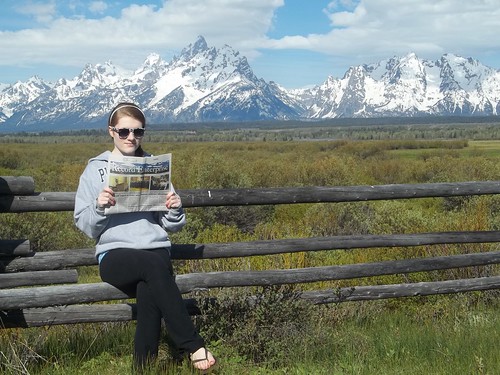The summer of 2011, my dad planned a trip to show me the Teton Mountain Range and Yellowstone, the first National Park in the world, created in 1872. We were scheduled to leave June 16th; the idea was to beat most of the other tourists. However, weird weather wreaked havoc on our plans both before we left New Hampshire and once we arrived out West. Who would have thought a strong wind burst would blow through Plymouth in June, snapping trees and causing a power outage resulting in school being cancelled for a day. I had to take several final exams early so we could leave on our scheduled flights. Then, once we arrived at our destination, as we drove through towns in Wyoming, Montana, Idaho, and Utah, we received flood warning messages on my Dad’s phone. The unusually high amount of snowfall from the winter was finally melting.

Heading into Yellowstone National Park
Visiting Yellowstone when there was still so much snow was mostly beneficial, as the animals were still in the lower elevations and there were fewer people and cars in the park. We saw more wildlife than I ever expected. The “watch for wildlife” signs along the road proved to be more than just a tease. Our first sighting was of a moose and her calf in Teton National Park followed by a herd of elk and their young as we approached Yellowstone Lake. We initially wondered when, and if, we would see bison. We ultimately saw so many bison with their calves that we lost count. Although we didn’t get stopped by bighorn sheep and calves crossing the road like we did with bison, we enjoyed watching them maneuver on a steep mountainside near the road. We also witnessed white mountain goats nursing their babies on a cliff near the northeastern entrance of the park, past Lamar Valley. As we hiked down to the lower waterfalls along the Yellowstone River, we watched an osprey fish and then feed its offspring in a nest perched on a pinnacle. Late spring/early summer is definitely a good time to visit Yellowstone.
If you ever travel to grizzly country, find some place to purchase pepper spray. All our bear sightings were in one day; we saw seven, ranging in color from golden to almost black. One or two looked to be grizzlies, including the one feeding on what looked like a bison carcass. The Park newsletter educates visitors to use the profile or shape, and not the size or color of the bear, to distinguish between grizzlies and “black” bears. Grizzlies have a big shoulder hump. In Hayden Valley we watched, from afar, a grizzly bear browse as her two yearling cubs played alongside. We found other tourists were happy to provide us with a close up view through their spotting scope. A week after we returned to New Hampshire a grizzly with cubs killed a man in Yellowstone, the first time in 25 years. Was it “our” grizzly - the one we watched?
We followed a wolf hunting and pouncing on something alongside the road; it turned out to be a coyote, but the chase was entertaining anyway. As it turns out, the only animal we didn’t see with the naked eye on our trip was a wolf, although folks with spotting scopes lined up alongside the road after dinner to watch a pack near a den take down an elk. The wolf story is controversial because 66 were successfully reintroduced in Yellowstone in 1995 and 1996. Many disagreed with this initiative as they thought wolves would move into the area on their own and didn’t need the government’s assistance or tax dollars. Wolves are now so plentiful that this past April, 2011, Congress removed gray wolves in certain states out West from the endangered species list, which means hunting will resume outside the park in some states beginning this fall.
People wonder how changing the gray wolf’s status in the West will affect the “eastern” wolf which is not protected. There have been four documented cases of wolves in the Northeast since the animal was added to the Endangered Species List, but no “confirmed” sightings in New Hampshire, my home state. Wolves used to be common in New Hampshire before there was a bounty for killing them and they were wiped out. Wolves live in Quebec and a female was killed within 20 miles of the New Hampshire border in Canada a few years ago, and people working in Waterville Valley have reported seeing wolves in the last couple of years. New Hampshire has the habitat to support a wolf population, but for now, travelling to Yellowstone is the best way to spot one, even if it’s through a scope.
Yellowstone surpassed my expectations. I was looking forward to seeing the colorful pools, hot springs and geysers which make Yellowstone so famous, but all the wildlife was an unexpected bonus.
Sydney Kahl is a member of the Youth Travel Blogging Mentorship Program.
Photo courtesy and copyright Sydney Kahl
References:
I used a Yellowstone National Park newsletter publication which was given to us at the Park that showed images and described how to recognize a grizzly bear.
I found the following blog site about wolves in New Hampshire: activerain.com/blogsview/1475514/have-wolves-returned-to-new-hampshire-
I also used the following site for information about the status of wolves: news.discovery.com/animals/gray-wolf-off-endangered-species-list-110504.html
